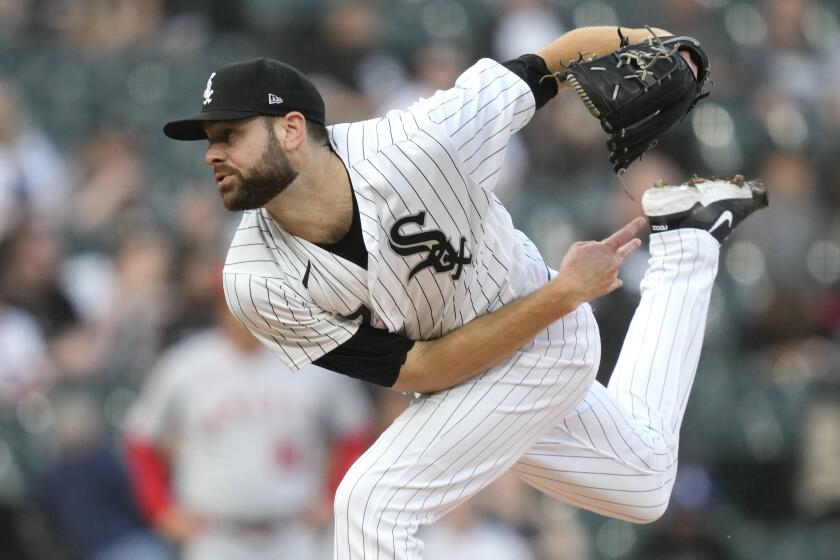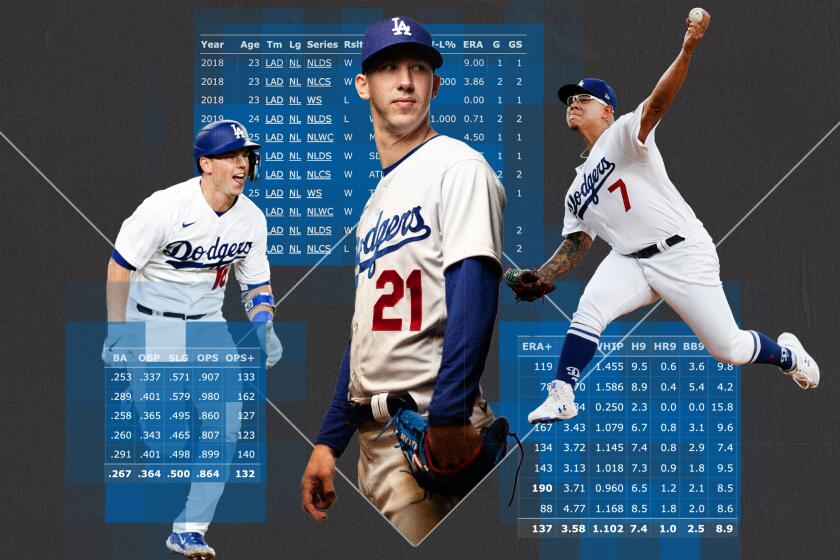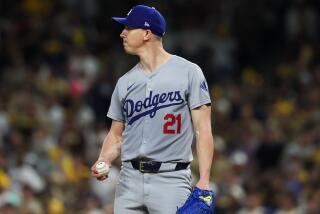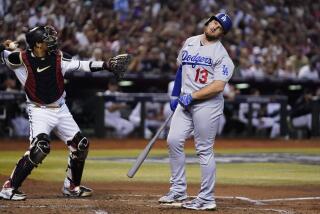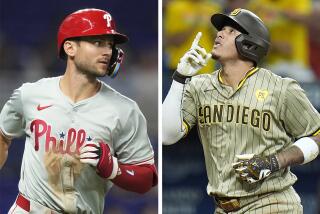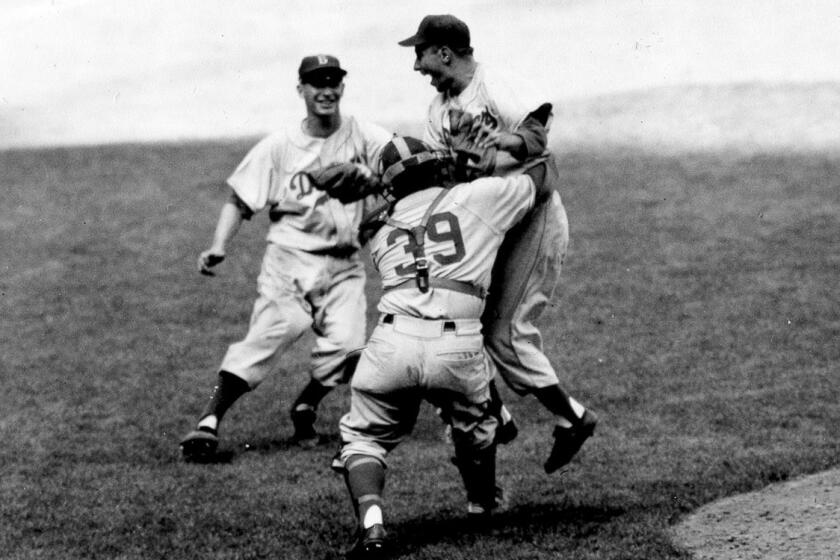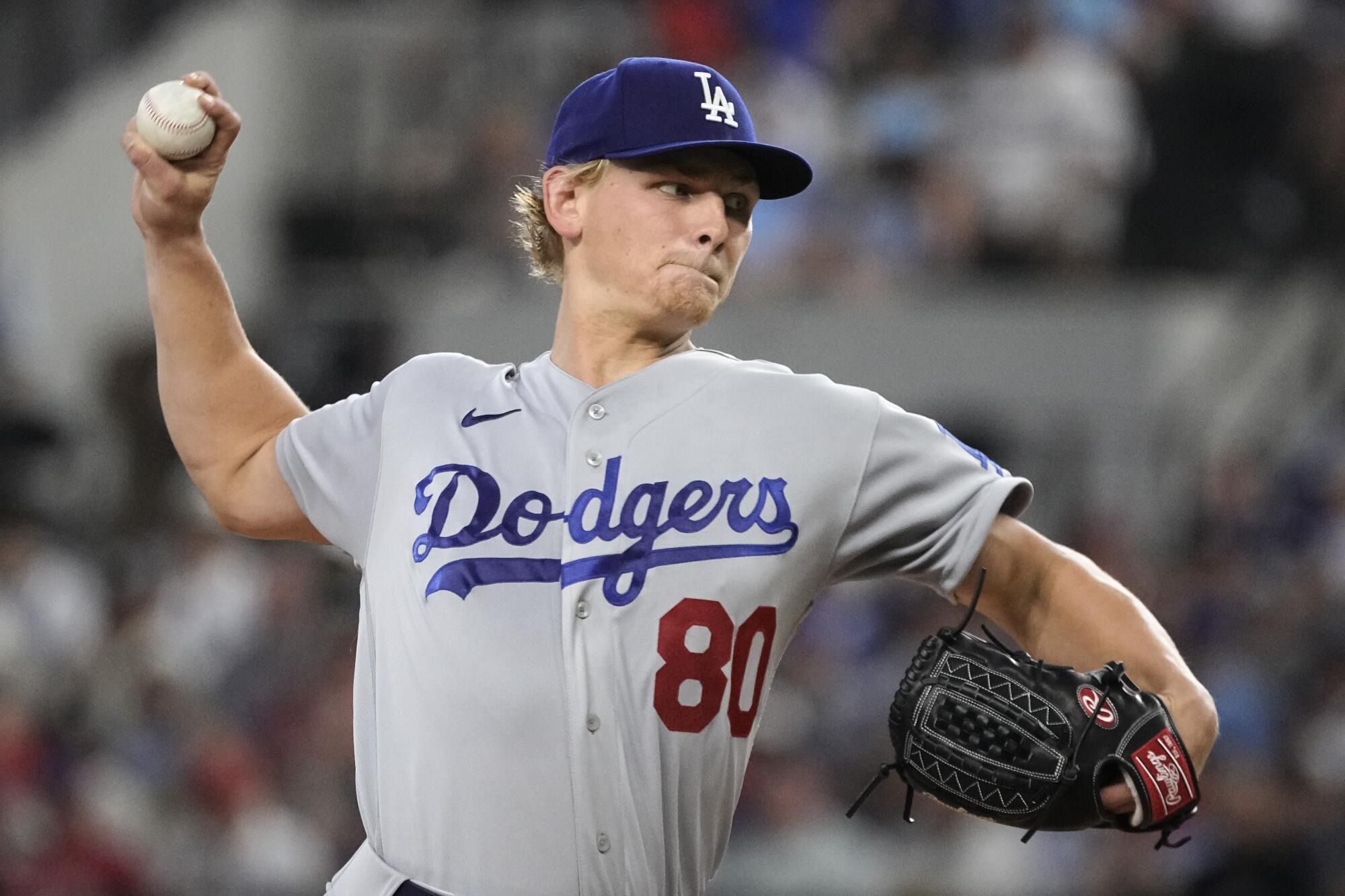
TULSA, Okla. — As stadium workers readied the Friday night fireworks beyond center field, and the rest of his Tulsa Drillers teammates victoriously returned to their clubhouse at ONEOK Field, Dodgers prospect Nick Nastrini took a deep breath.
“I get a little emotional when I think about it,” the right-handed pitcher said. “No one else really had any faith in me. The Dodgers were the only organization.”
On this night, Nastrini had taken another small step up the club’s minor league ladder.
In one of his best starts of the season with the double-A affiliate in Tulsa, he gave up two runs in a 5 ⅔-innings start, flashing the ever-promising power and ever-improving command that have made him a legitimate potential future big leaguer.
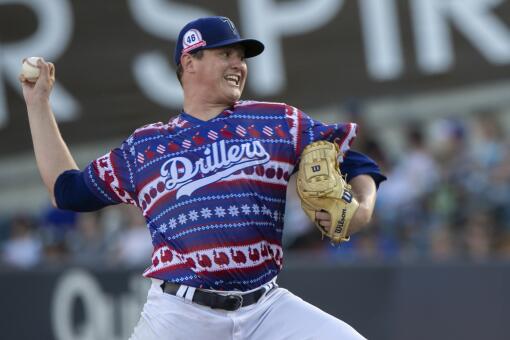
Dodgers’ farm system success
This is the second in a three-part series analyzing the Dodgers farm system’s decade of success, and how it has helped turn the club into one of baseball’s best organizations.
⚾ Part 1: Inside the Dodgers’ juggernaut farm system, the lifeblood of the club
⚾ Part 3: How the Dodgers farm system factors into their deadline plans, Shohei Ohtani pursuit
“I definitely need to get a lot better,” he said. “But I’ve got my foot on the gas. I’m not gonna stop anytime soon.”
Like many young pitchers in the Dodgers system, Nastrini’s major league dreams once looked far from certain.
A standout talent as an underclassman at UCLA four years ago, Nastrini spiraled in his junior year. His mechanics got out of whack. He got a serious case of the yips, walking 38 batters in 31⅓ innings. Once seen as a possible first-rounder, his draft stock plummeted. He wasn’t sure how many teams would take a chance on him.
Then, the Dodgers selected him in the fourth round.
And under their guidance, he has flourished again.
“I knew that I could do it. I just needed someone to give me a chance,” Nastrini said. “And I had no clue how good they were at development until I got here. I’m so, so happy I’m with them. It leaves me a little emotional when I think about it.”
Stories like Nastrini’s aren’t rare in the Dodgers’ minor-league system.
Instead, an organization that has historically been defined by pitching excellence is lapping the sport now in pitching development, providing its all-important pipeline with a steady flow of promising young arms.
It’s one of the things the Dodgers do best, taking imperfect pitchers with one or two intriguing attributes — in Nastrini’s case, his riding fastball that can reach the upper 90s — and then rounding out the rest of their skill set, either by adding velocity or spin, cleaning up mechanics to improve command, or introducing a new mix of complementary pitches.
The Aug. 1 MLB trade deadline is approaching and the Dodgers are in need of starting pitching, relief pitching and bench help. Will they make a move?
“It’s pretty ridiculous how they’re the high team on so many good pitching prospects,” one rival scout said.
Nowhere has that process been more evident this year than Tulsa, where the affiliate’s pitching staff has captured the attention of the industry.
The Drillers have the lowest earned-run average and highest strikeout rate in their league. They were also singled out by Baseball America as the hardest-throwing team in professional baseball — majors or minors — at one point this season, averaging 94.8 mph prior to the promotions of some of their best arms.
Almost all of the Drillers’ success has come from a collection of mid-round draft picks and once-unheralded prospects, a treasure trove of uncovered gems who have raised the stock of the Dodgers’ farm system and provided a template the team hopes to keep replicating.
“It’s a special group,” Nastrini said. “I’m excited to look back in a few years and see where we’re all at.”
The Dodgers’ approach to pitching development isn’t revolutionary.
They aren’t the only club that seeks out unique characteristics in the pitchers they draft or acquire. They aren’t the only ones drawn to big fastballs or nasty breaking pitches or funky deliveries that can serve as the foundation for future growth.
Even once-novel methods like weighted-ball velocity training or high-data pitch analysis are no longer rare in the industry, either.
Yet, in recent years, the Dodgers system has been more productive than most — especially with later-round, less-polished prospects who consistently improve under their instruction.
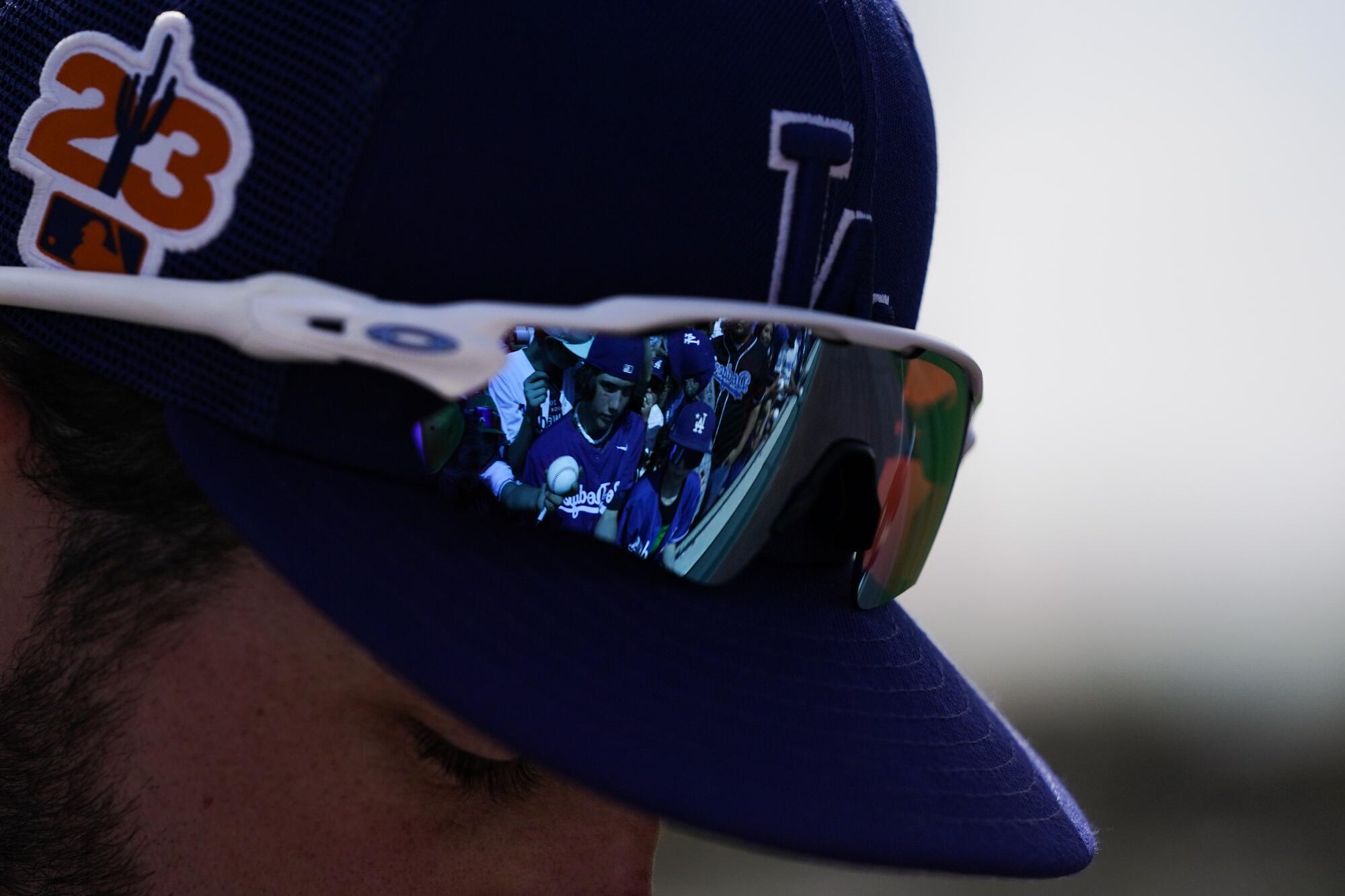
It starts with scouting. Of the four Dodgers pitchers in MLB Pipeline’s top-100 prospect rankings, three were drafted in the third round or later. Of the six starters that began the season in Tulsa, none were taken in the first round.
“Billy [Gasparino, the Dodgers vice president of amateur scouting] is on a heater drafting arms,” the rival scout said. “They haven’t really missed on many pitching picks the past few years.”
From there, the pitching department has become the engine of development, following what Tulsa co-pitching coach Ryan Dennick described as a three-step plan applicable to all pitching types.
The first focus is strength, making sure each prospect is at their physical peak before considering massive overhauls to their delivery.
The next is on technique, evaluating the mechanics of each prospect to make sure their throw is maximizing whatever unique skill that had their scouting department originally intrigued.
“They all had their warts,” Dennick said. “But do they have the inputs we’re looking for? Can we mask their inefficiencies and maximize their effectiveness? I think that’s what we’ve done with [this group] in particular.”
Those steps are often addressed months earlier and two states away.
Where many prospects once went to private training centers like Driveline and Tread Athletics to improve, the Dodgers have created their own pitching camps in recent offseasons, hosting many of their prospects at their Camelback Ranch facility in Arizona during the winter.
There, they can foster growth in real time. If a pitcher’s throw looks off, a KinaTrax biometric system will show even the smallest variations in their delivery. If they need to build strength or add mobility, the Dodgers player performance staff is on-hand to assist.
“It’s a special group. I’m excited to look back in a few years and see where we’re all at.”
— Dodgers prospect Nick Nastrini
“The more time we can get around these guys, the easier it is to hone on, ‘What is the actual problem?’” said director of minor league pitching Rob Hill, a former Driveline instructor who has helped implement the offseason program. “We get to understand more about how they respond to certain stimuli, and then make our adjustments from there.”
Once a pitcher’s strength and delivery are refined, the third step — the tactical refinement — is layered in, with pitchers tinkering with their arsenals and learning which pitches to throw in game situations.
That’s the stage Nastrini and the rest of the Tulsa pitching staff have reached this year, helping a group of once lower-profile prospects emerge as possible big-league talents.
“It’s been unbelievable,” Tulsa’s other pitching coach, Durin O’Linger said. “Dennick and I would just sit back and watch them go about their daily business, because they did such a good job on the prep side.”
Emmet Sheehan (a sixth rounder in 2021) became the first Tulsa pitcher this year to reach the big leagues, honing his funky sidearm delivery and highly touted fastball. Landon Knack (a second rounder in 2020) is close behind him following a promotion to triple-A Oklahoma City.
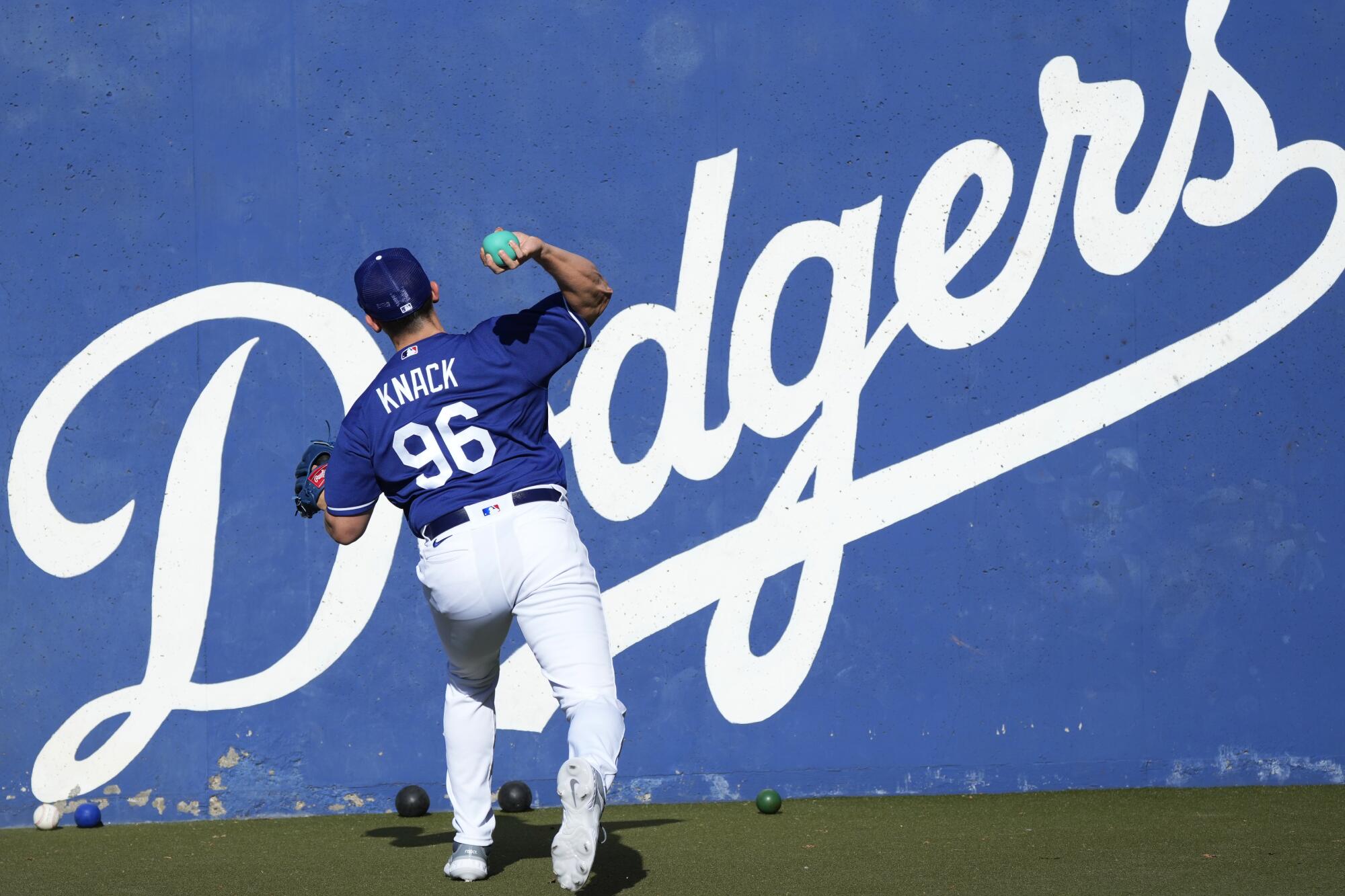
Back in Tulsa, three other starters have turned heads this season.
River Ryan is a former two-way player whose breakout with the Dodgers has been all about mentality: “They tried to relate everything to me playing shortstop,” he said. “Everything just kind of fell in place after that.”
Nick Frasso is flame-thrower with his own deceptive delivery, firing triple-digit heat from his 6-foot-5 frame: “They’re very analytical,” he said of the Dodgers minor league staff. “They really point out what you do well and help you bring that ceiling up even more.”
Kyle Hurt is a right-hander with a promising fastball-changeup combination, as well as natural “counter-rotation” in his delivery that has forged more consistent mechanics: “It’s a small little reminder of, that’s where my power, my stuff comes from.”
That trio — which all possess big-league potential, according to evaluators with the Dodgers and around the industry — has been a particular success story for the club. They were each acquired in minor trades over the last three years (Ryan for Matt Beaty, Frasso for Mitch White, Hurt for Dylan Floro). Upon joining the Dodgers, they’ve each taken off.
“Once you’re in our system, we’re pouring lots of bandwidth into you,” general manager Brandon Gomes said. “It’s just about trying to identify those areas of growth, while not losing the strength — the ‘superpower’ — of each guy.”
At the start of this season, few of those double-A arms were on much of a big-league radar.
For the Dodgers, it was the class of pitching prospects above them — including Bobby Miller, Gavin Stone, Michael Grove and Ryan Pepiot — that were on the doorstep of the majors, garnering attention as the club’s latest wave of pipeline talent.
Now, however, Sheehan is holding down a place in the Dodgers MLB rotation. Knack, whose career was in danger of stalling after a poor 2022, was briefly on their taxi squad prior to the break.
The others could be more in the picture later this year, if needed. Or, they could also serve as enticing trade fodder, valuable prospects that wouldn’t subtract from the Dodgers championship-minded first-place team.
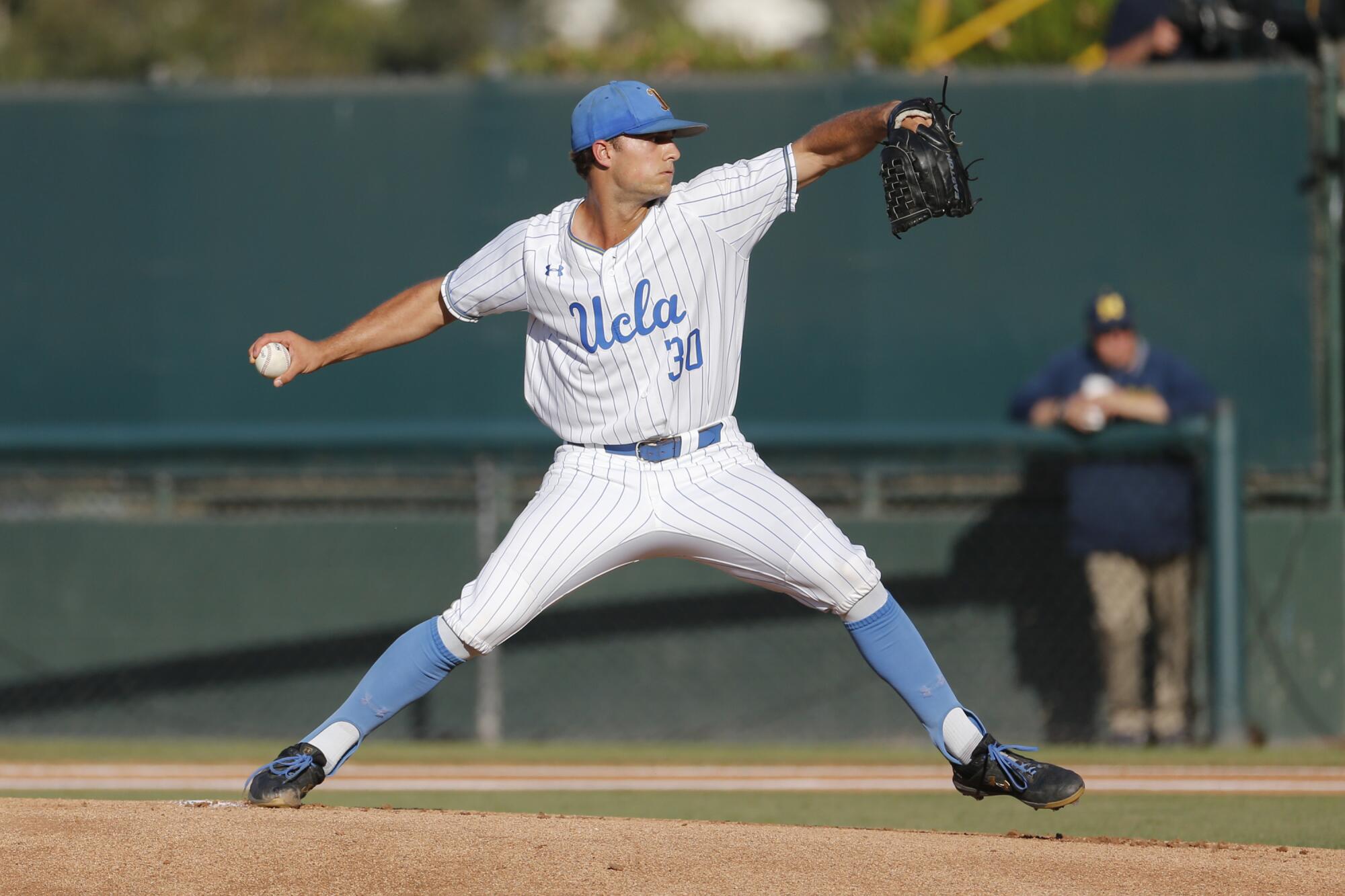
It’s the place the club wants to be every year — promoting one generation of prospects to the majors, while ushering another one up the farm system right behind them.
“I want people saying, ‘How the hell are these guys all at the same [minor-league] level?’” Hill said. “Like the hydra, when you cut one head off and two more grow in its place. That’s what all of us are working towards.”
In Tulsa, it has created a competitive environment, each of the pitchers pushing the others to be better.
Dennick recalled one week early in the year when Sheehan struck out 10 batters in a game, only for Hurt to match the feat two days later. At another point, Frasso became the first of the group to regularly start eclipsing 100 mph in a game. Then, Ryan suddenly flashed 101 on the stadium radar gun.
“They all see themselves as a big-leaguer,” Dennick said. “Which is really cool to see.”
The Dodgers’ consistent development of minor leaguers to supplement their star-studded roster has made them one of baseball’s top organizations.
They insist there’s no ego between them. When Sheehan ascended to the majors, the rest of the Tulsa team celebrated the promotion.
At the same time, though, “They lack self-doubt,” Dennick said. “Honestly, you need confidence in this game. And they show it. They know they’re good. But they know there is more in the tank, too.”
That last part, the Dodgers hope they can take care of. After years of refining their pitching development system, aiming to turn unfinished prospects into well-rounded future MLB arms, their Tulsa rotation is becoming a defining example.
“We’ve maximized their strengths the best we can,” Dennick said. “And I think we’re really starting to see what those guys can become.”
More to Read
Are you a true-blue fan?
Get our Dodgers Dugout newsletter for insights, news and much more.
You may occasionally receive promotional content from the Los Angeles Times.

